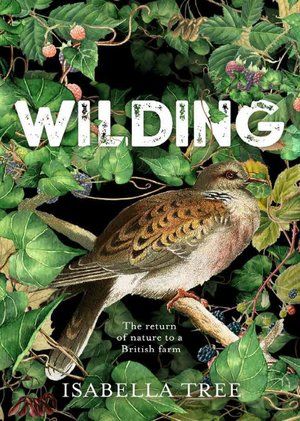
Wilding; the Return of Nature to a British Farm
Wilding raises two key issues. One is the challenge it poses to the established UK approach to nature conservation, and our approach to nature more generally. The other is whether we have more than enough food and should instead of producing food give land, such as that at Knepp over to Nature.

Published by Picador, 2018
Everyone I know who is involved in managing land for nature conservation has been enthused by this book. The writers of the long running Radio 4 soap opera, The Archers, have clearly read it as Ambridge (the fictional village where The Archers is set) now has a rewilding project. Isabella Tree has even made it to being a guest on Desert Island Discs, another Radio 4 programme. An author and travel writer, Isabella Tree is married to Charlie Burrell who, in 1987 inherited the Knepp Estate in West Sussex from his grandparents.
The estate was losing money and Charlie Burrell set about trying to turn it around by becoming the best conventional farmer he could be, amalgamating dairy herds, investing in new machinery, intensifying production and diversifying into ice cream production. However, by 1999 the farm was again in financial crisis when the Burrells brought in an expert on veteran trees, Ted Green, to advise them about the Knepp Oak, whose gigantic outstretched limbs seemed to be in danger of tearing the tree apart. Ted pointed out that all their old oaks were in a poor condition because the land around them was being ploughed and doused with chemicals for arable production. This visit catalysed a rethink by the Burrells that led to the sale of the dairy herds and farm machinery in 2000, the restoration of parkland in the area around the veteran trees in 2001 then, from 2003, the gradual cessation of arable production over the rest of the 3500 acre estate and creation of the Knepp Wildland Project. Wilding is an engaging account of this process and contains some great nature writing. For me it raises two key issues. One is the challenge it poses to the established UK approach to nature conservation, and perhaps our approach to nature more generally. The other is whether we have more than enough food and should instead of producing food give land such as that at Knepp over to Nature.
The UK approach to nature conservation is epitomised by the response the Burrells got to their proposal to English Nature in 2002, to establish a ‘biodiverse wilderness area’ with free roaming wild animals, similar to that in Oostvaadersplassen in the Netherlands (p.72). The woodland scientist from English Nature who came to see them “talked of computer modelling, targets, safeguards, setting parameters for the number of animals and vegetation cover and lots and lots of further research” (p.76). Nature conservation has been driven by identifying target species in need of preservation then providing the habitat and other conditions we think they need. It tends to be a static approach: the aim is to keep things as they are. In contrast Knepp and rewilding projects such as Wild Ennerdale in Cumbria, aim to restore natural processes; process that are dynamic and lead to continual change in the landscape. In Ennerdale this involved removing barriers to the movement of sediments in the river and tree planting to provide seed sources for regeneration of native woodland species, as well as grazing by a small herd of Galloway Cattle (p.224). At Knepp it has involved the cessation of arable farming and, after waiting for a few seasons to allow the growth of scrub vegetation, introducing the right sort of herbivore: longhorn cattle, red and fallow deer and Exmoor ponies. Sheep, in contrast, are the wrong sort of herbivore: they would not have been part of the natural mix of herbivores in Western Europe, having been introduced from Mesopotamia (p.67), they graze grassland to a closely cropped sward and compact the soil. The cattle are not there primarily to produce meat (though they do), as they would be in a farming system. Rather they are substitutes for the now extinct aurochs (wild ox) that once roamed Britain. Longhorns are able to pretty much able look after themselves outside all year round, including (most of the time) when calving. Importantly, the cattle and horses at Knepp are not given the wormers and parasiticides that are routinely given to most livestock in the UK and devastate the dung beetle population: Tree recounts how her husband, Charlie, became fascinated by dung beetles and was very pleased one summer when he managed to find 23 species in a single cow pat (p. 114). The herbivores at Knepp add disturbance to the ecosystem, creating more diversity and producing a continually shifting mix of pasture and scrub.
As well as the herbivores the Burrells have introduced Tamworth pigs as substitute wild boar. These wreaked havoc turning over the soil of the manicured verges of the drive and along the footpaths (the only areas, Tree says, that had not been ploughed or doused with agrochemicals and therefore contained good populations of earth worms, rhizomes and other life – p.110). However the pigs’ ability to ‘churn acres into the battlefield of the Somme in a matter of hours’ had its upside: in the growing season pioneer plants and invertebrate species would appear within days on disturbed land (p.111), adding to biodiversity.
The result of allowing natural processes to take their course has been that Knepp now supports a vast array of wildlife, including several species which are in precipitous decline elsewhere in the country, the most important of which are the turtle dove, the nightingale and purple emperor butterfly. Tree explains how the habitats of these species at Knepp are often not those they are normally thought to need. For example, the purple emperor is considered to be a butterfly of ancient, closed canopy woodland but at Knepp it is found in emerging sallow scrub (p.177). And if they had been trying to attract nightingales the Burrells would have been advised that they required coppiced woodland, but at Knepp nightingales have taken up residence in overgrown hedges where there is thorny cover right down to the ground (p. 190). They also have peregrine falcons, birds that are normally thought to nest on cliffs, nesting in a pine tree. This illustrates how much we don’t know about nature. Rather than forming a view about what we want to achieve then managing things so as to try to achieve it, perhaps we ought to work with nature, remove the obstructions we have created to natural processes and let nature take its course more often.
The changes in the landscape at Knepp did not meet with universal approval.
One the contrary, there was, in the early days, a great deal of local hostility to what was happening. Explaining the views of objectors Tree says: ‘abandoning the land to nature.... – ‘letting it go’ – smacked of laziness, irresponsibility, even immorality. It was uncivilized, a ‘backward step.’ To some it was ‘wanton vandalism’ (p.130). Behind these sentiments was firstly, an aesthetic dislike of the scrub vegetation developing on the once ordered unfarmed fields, but more importantly the idea that the land should be used for food production. Tree quotes a letter to the Country Times: “When it was farmed first by Sir Merrik and then Sir Walter and Lady Burrell, [Knepp] was an estate admired and worked by people proud of its high standard of farming and general care...... In this day and age when we are asked to grow all the food we can, to save importing and help feed starving countries, he has turned a fine working estate into a wasteland ..... Someone needs to stop him.” (p.131).
More measured concerns about the impact of rewilding of farmland in lowland Britain on our ability to feed ourselves are expressed by Simon Fairlie in an article in The Land (Issue 24, p.40-42, 2019). He was given a tour of the land by Charlie Burrell in October 2018. This article gives interesting information about the Knepp Estate’s income sources. It gets approximately £300,000 each from: letting of residential property (which previously housed farmworkers), letting of office property, public tours of the estate (around £40 for half a day), sale of meat and finally agricultural subsidies. Fairlie points out that the food being produced is tiny – about 35 tonnes of organic pasture-fed meat per year, equivalent to 10 kilos per acre. This is less that would be obtained from a dairy herd as a by-product. Fairlie says:
“The UK only produces 60 percent of the food it eats. If that level of production were to drop further as a result of large scale rewilding and similar environmental schemes, then the most likely scenario is that the UK would make up the balance with imports from elsewhere. In a post-Brexit Britain, many such imports will be unsustainably produced – South American soya and beef, Indonesian palm oil, Californian almonds, or sugar from land-grab plantations in Africa, for example. If, by rewilding at home, the UK increases its dependence on imported food, we will be outsourcing our environmental impacts and creating pressure for dewilding somewhere else. On a global scale it will be a zero sum game.”
Tree sees arguments about the need to increase food production (by 70-100% to feed the predicted rise from 7 billion to 10 billion people by 2050) as driven by food producers, retailers, agri-business and farmers’ unions and at odds with the experiences of farmers struggling to make a profit in global markets (p.132). In reality, she says, globally we already produce enough food to feed 10 billion people but a third of what is produced is currently wasted (see also our Green Read on Mike Berners Lee’s There is no Planet B). Tree goes into some detail on all the ways this occurs and how remarkable advances in agricultural technology have dramatically increased yields in recent decades (p.132- 135). Knepp is actually on poor soil – a wet clay which is difficult to work – and produced lower yields than farmers on better land, with whom they could not compete. During the agricultural depression of the 1930s much of the estate was allowed to revert to scrub. Perhaps the fact that we only produce 60 percent of the food we eat is not because we could not produce more but because of the way the food system works and our diets have changed? We eat pasta imported from Italy rather than our home grown potatoes; supermarket requirements for vegetables mean much of what is grown is rejected; we import vegetable oils rather than using the fat from British livestock. Getting British farmers to grow more potatoes will not, by itself, lead to people eating potatoes rather than imported pasta. If we want to increase the amount of UK food that we eat we should look first at how the food market is currently working for our farmers and growers, rather encouraging them to increase production. Food production comes at a cost to wildlife, the climate, water and air quality. In a rational world we would aim to produce just what we need – and ensure that everyone has access to it - not more. There are now calls for the half of UK farmland which produces just 20% of our food to be converted to natural habitats, to sequester carbon, reduce flooding and for human enjoyment, as well as to boost wildlife populations.
One word of caution is that while wilding as carried out at Knepp is clearly of benefit to wildlife, and will do something to absorb carbon dioxide when compared with the previous farming regimes, it should not be seen as a panacea when it comes to climate change. It does not obviate the need for a rapid movement away from use of fossil fuels. However, in conjunction with stopping fossil fuel use, it could provide a chance for wildlife in the UK to survive the changes in the climate we are going to see in the years ahead and reduce the impact on us of extreme weather events, such as droughts and floods.
In her Desert Island Discs interview Tree talks about how one of the hardest things they did was to make their farm manager redundant. It is clear that their experiment has come at a cost to those who previously worked for them in farming jobs. One challenge for wilding elsewhere will be whether those impacts on jobs can be avoided and people be given perhaps different but still meaningful work when conventional farming has been abandoned. The Lowther Estate in Cumbria, for example, is embarking on ‘Wildland Farming’, with longhorn cattle and Tamworth pigs, plus plans for beavers, clearly inspired by Knepp. This is after trying organic poultry, beef and sheep (which proved unviable) then conventional sheep and arable (also unviable). Like Knepp they have had a farm sale to dispose of all their machinery and sheep but, apparently, none of their employees have been laid off (information from Jim Bliss, in response to a question at an event in Kendal on 14 February 2020). Let us hope this can be replicated elsewhere.



